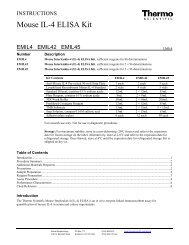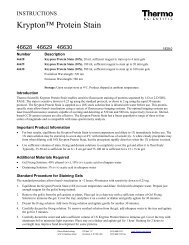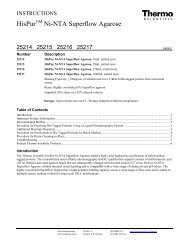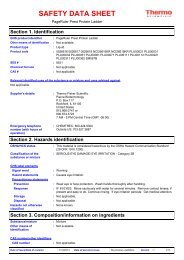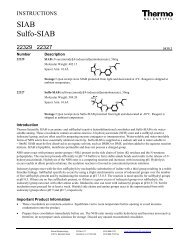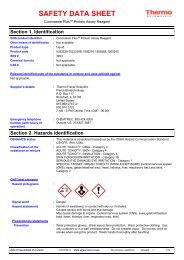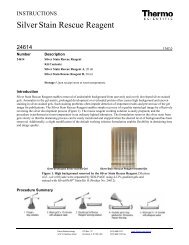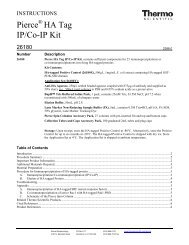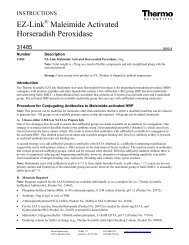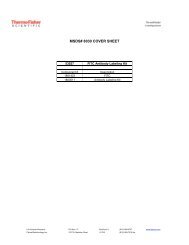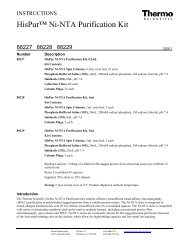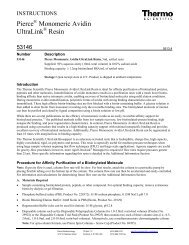Thermo Scientific Pierce Protein Assay Technical Handbook Version 2
Thermo Scientific Pierce Protein Assay Technical Handbook Version 2
Thermo Scientific Pierce Protein Assay Technical Handbook Version 2
You also want an ePaper? Increase the reach of your titles
YUMPU automatically turns print PDFs into web optimized ePapers that Google loves.
<strong>Pierce</strong> 660nm <strong>Protein</strong> <strong>Assay</strong><br />
Methods:<br />
Spectral Analysis: The absorption spectra from 340 to 800nm<br />
were recorded using a Varian Cary Spectrophotometer of the<br />
following component combinations: the <strong>Pierce</strong> 660nm <strong>Protein</strong><br />
<strong>Assay</strong> Reagent alone and in the presence of the transition metal;<br />
100µg of bovine serum albumin (BSA) and reagent with and<br />
without metal; and 200µg of BSA with the reagent and metal.<br />
Absorbance (660nm)<br />
1.5<br />
1.0<br />
0.5<br />
BSA<br />
BGG<br />
Typical Response Curves<br />
Test Tube Procedure: To each test tube containing 0.1mL of BSA<br />
or BGG standard replicate (25, 50, 125, 250, 500, 750, 1000, 1500<br />
and 2000µg/mL) in saline, 1.5mL of the <strong>Pierce</strong> 660nm <strong>Protein</strong><br />
<strong>Assay</strong> Reagent was added, mixed well and incubated at room<br />
temperature for 5 minutes. The absorbance of all samples and<br />
controls was measured at 660nm. The average absorbance for<br />
the blank replicates (control) was subtracted from the absorbance<br />
for individual standard replicates. A standard curve was<br />
generated by plotting the average blank-corrected 660nm<br />
measurement for each standard versus its concentration. For<br />
a comparison study, the standard Bio-Rad Bradford <strong>Assay</strong> was<br />
performed as per manufacturer’s directions.<br />
Net Absorbance (660nm)<br />
3<br />
2<br />
1<br />
BSA<br />
BGG<br />
0<br />
0 500 1,000 1,500 2,000 2,500<br />
<strong>Protein</strong> (µg/mL)<br />
Figure 2. Typical color response curves using the test tube procedure. The<br />
linear detection ranges are 25-2,000µg/mL for bovine serum albumin (BSA) and<br />
50-2,000µg/mL for bovine gamma globulin (BGG). The average absorbance for<br />
the blank replicates (control) was subtracted from the absorbance for<br />
individual standard replicates.<br />
Microplate Procedure: To each well containing 0.01mL of BSA or<br />
BGG standard replicate (25, 50, 125, 250, 500, 750, 1000, 1500 and<br />
2000µg/mL) in saline, 0.15mL of the <strong>Pierce</strong> 660nm <strong>Protein</strong> <strong>Assay</strong><br />
Reagent was added. The plate was covered with sealing tape,<br />
mixed for one minute on a plate shaker and incubated at room<br />
temperature for five minutes. The plate reader was set to 660nm<br />
and using the control as a blank, the absorbance of all samples<br />
was measured. A standard curve was generated by plotting the<br />
average blank-corrected 660nm measurement for each standard<br />
versus its concentration.<br />
0<br />
0 500 1,000 1,500 2,000 2,500<br />
<strong>Protein</strong> (µg/mL)<br />
Figure 3. Typical color response curves using the microplate procedure. The<br />
linear detection range is 50-2,000µg/mL for bovine serum albumin (BSA) and<br />
bovine gamma globulin (BGG). The average absorbance for the blank replicates<br />
(control) was subtracted from the absorbance for individual standard replicates.<br />
Net Absorbance (660nm)<br />
3<br />
2<br />
1<br />
<strong>Thermo</strong> <strong>Scientific</strong> <strong>Pierce</strong><br />
660 <strong>Protein</strong> <strong>Assay</strong><br />
Bio-Rad <strong>Protein</strong> <strong>Assay</strong><br />
0<br />
0 500 1,000 1,500 2,000 2,500<br />
BSA (µg/mL)<br />
Figure 4. Performance comparison of Bradford <strong>Protein</strong> <strong>Assay</strong> versus the<br />
<strong>Thermo</strong> <strong>Scientific</strong> <strong>Pierce</strong> 660nm <strong>Protein</strong> <strong>Assay</strong>. <strong>Assay</strong>s were performed<br />
according to the standard test-tube procedure using 100µL of BSA. The <strong>Pierce</strong><br />
660nm <strong>Protein</strong> <strong>Assay</strong> has a greater linear range of 25-2,000µg/mL, compared<br />
with the Bradford <strong>Assay</strong>, which has a linear range of only 125-1,000µg/mL.<br />
References<br />
1. Bradford, M.M. (1976). A rapid and sensitive method for the quantitation of microgram<br />
quantities of protein utilizing the principle of protein-dye binding. Anal. Biochem.<br />
72, 248-254.<br />
2. Gornall, A.G. (1949). Determination of serum proteins by means of the biuret reaction.<br />
J. Biol. Chem. 177, 751-766.<br />
3. Lowry, O.H. (1951). <strong>Protein</strong> measurement with Folin-Phenol reagent. J. Biol. Chem.<br />
193, 265-275.<br />
4. Smith, P.K., et al. (1985). Measurement of protein using bicinchoninic acid.<br />
Anal. Biochem. 150, 76-85.<br />
5. Stoscheck, C.M. (1987). <strong>Protein</strong> assay sensitive at nanogram levels. Anal. Biochem.<br />
160, 301-305.<br />
Ordering Information<br />
Product Description Pkg. Size<br />
22660 <strong>Pierce</strong> 660nm <strong>Protein</strong> <strong>Assay</strong> Reagent 750mL<br />
Sufficient reagent for 500 standard assays and<br />
5,000 microplate assays.<br />
22662 <strong>Pierce</strong> 660nm <strong>Protein</strong> <strong>Assay</strong> Kit<br />
Sufficient reagent to perform 300 standard assays<br />
and 3,000 microplate assays.<br />
Contains: <strong>Pierce</strong> 660nm <strong>Protein</strong> <strong>Assay</strong> Reagent<br />
Kit<br />
450mL<br />
Pre-Diluted <strong>Protein</strong> <strong>Assay</strong> Standards,<br />
Bovine Serum Albumin (BSA) Set<br />
3.5mL each of 125- 2,000mg/mL BSA<br />
22663 Ionic Detergent Compatibility Reagent<br />
Sufficient for treating 100mL <strong>Pierce</strong> 660nm<br />
<strong>Protein</strong> <strong>Assay</strong> Reagent.<br />
5 pouches, 1 gram each<br />
5 x 1g<br />
14<br />
For more information, or to download product instructions, visit www.thermoscientific.com/pierce



